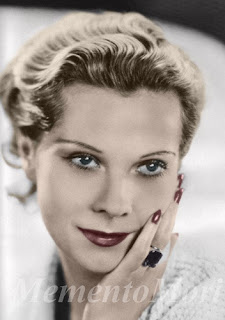Dorothy Virginia Margaret Juba (December 11, 1927 – May 3, 1990), later known as Dorothy Horan, and best known as Dovima, was a model during the 1950s.
Born in New York City, Dovima was discovered on a sidewalk in New York by an editor at Vogue, and had a photo shoot with Irving Penn the following day. She was an overnight success and soon was the highest paid model in the business.
Jerry Ford of Ford Models said, "She was the super-sophisticated model in a sophisticated time, definitely not the girl next door."
She worked closely with Richard Avedon, whose photograph of her in a floor-length black evening gown with circus elephants—"Dovima with the Elephants"—taken at the Cirque d'hiver, Paris, in August 1955, has become an icon.
The gown was the first evening dress designed for Christian Dior by his new assistant, Yves Saint-Laurent.
The half-Polish, half-Irish daughter of Stanley Juba, she was raised in Jackson Heights, Queens.
She contracted rheumatic fever at age ten and was confined to bed.
The standard treatment was a year in bed, but her overprotective mother kept her home for the next seven years. It was a lonely time for her. She took up painting and had an imaginary friend, whom she called Dovima- using the first two letters of each of her given names. Doe, as her family called her, only socialized by telephone with other invalid children that her tutor educated.
It's not too surprising then that her first husband, Jack Golden, was an upstairs neighbor. He simply moved into Doe's bedroom in her family's home.
 |
| Photo Richard Avedon |
She appeared on the covers of all the fashion magazines and worked with every major photographer of the day. She formed a particular bond with Richard Avedon who would take the most famous photos of Dovima.
After her death, Richard Avedon said, "She was the last of the great elegant, aristocratic beauties...the most remarkable and unconventional beauty of her time."
On another occasion, Avedon said, "The ideal of beauty then was the opposite of what it is now. It stood for an extension of the aristocratic view of women as ideals, of women as dreams, of women as almost surreal objects. Dovima fit that in her proportions."
 |
| Richard Avedon , Dovima in Balenciaga |
Dovima and Jack Golden divorced in the late fifties and she married Alan Murray. She let him handle all of their finances as Jack Golden had. They had a daughter, Alison.
Alan Murray is remembered as a man with boundless anger.
In Vanity Fair, Mimi Swartz wrote, "That at times her husband beat her so severely that she could not show up for work did not, at first, cut into her bookings."
Carmen Dell'Orefice commented on Dovima's love life, "Sadly she could only be with men who beat her. I'd find her on my doorstep black and blue, and I'd take her in and she'd live with me."
In 1960 she moved with Alison to Los Angeles to pursue acting work. Murray told the FBI that Dovima had kidnapped their daughter. The two divorced and she lost custody of Alison.
Dovima never saw her again.
Dovima appeared in 1957's Funny Face with Audrey Hepburn and Fred Astaire. The musical was loosely based on Richard Avedon. In fact Avedon shot the fashion pictures that appear in the film, and the photographer that Astaire plays is named "Dick Avery". Dovima plays ditzy fashions model Marion. She has only a few scenes, but comes off very funny and glamorous.
 |
| Photo by Horst P.Horst |
She announced her retirement from modeling in 1959, but actually posed until 1962.
Of retiring, Dovima said, "I didn't want to wait until the camera turned cruel."
Unfortunately she hadn't saved any of her money.
When the TV appearances dried up, she spent the late sixties and early seventies working as a spokesperson for Qiana, a clothing line.
In 1974, she moved to Ft. Lauderdale to be near her parents and held various jobs like selling cosmetics and hosting at restaurants.
She fell in love with a co-worker, bartender West Hollingsworth with whom she had twelve happy years.
They married in 1983, but Hollingsworth died of cancer in 1986. It was a devastating blow to her and she never really recovered.
 |
| Dovima for Lanvin by Henry Clarke |
In 1984 she went to work in Pizzeria as a hostess.
She said she worked with nice people and was the mascot for their softball team.
She enjoyed her status as kind of local celebrity. She commented in 1987, "The only 'has been' is one who has been. You have to Have Been in order to be a has been."
She died of liver cancer on May 3, 1990.
What she left behind are photographs that are a part of our culture. Images that speak of a time and a dream, that somehow speak volumes yet nothing at the same time.













































